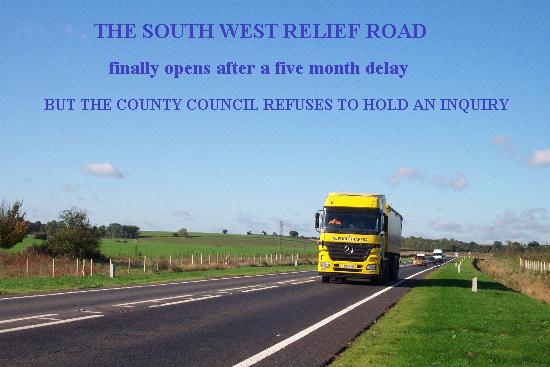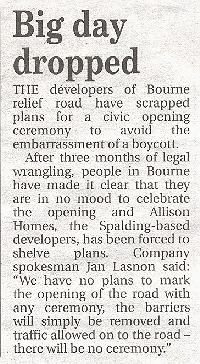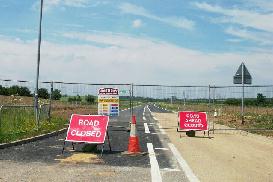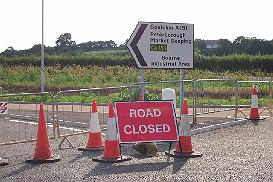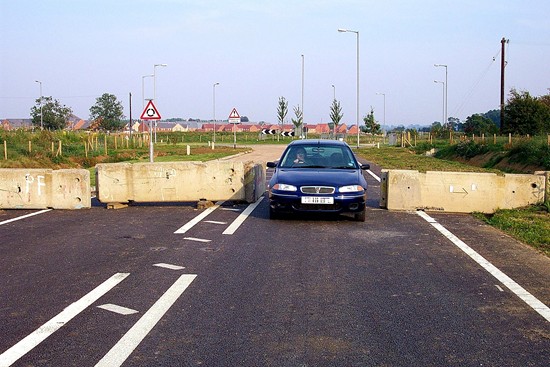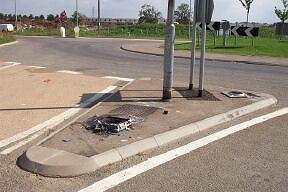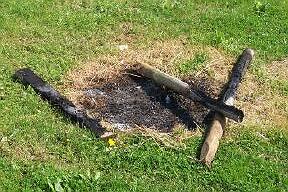|
THE SOUTH WEST relief road opened on Saturday 8th October 2005 after eighteen weeks of enforced closure by the developers, Allison Homes. Their dispute with the highways authority, Lincolnshire County Council, was finally settled and the new 1½-mile stretch of carriageway was soon taking through traffic away from the town centre as it should have been for the previous five months although there will be no inquiry into the delay. An official opening had been planned and there was talk of a ribbon-cutting ceremony, a brass band, a Continental market and a running race to mark the event but these suggestions were eventually scrapped for fear of a boycott by the public and local councillors as a mark of protest over the delay in bringing the new road into use. Such ceremonial was seen by some as an attempt by Allison Homes, part of the Kier Group, to appease the public who were incensed by the continued closure while traffic piled up in the town centre streets and could even have been prompted by a tragic death in Abbey Road on Monday 12th September 2005 when a fifteen-year-old schoolboy cyclist was killed after being in collision with a tipper lorry. The fatality may have had no connection whatsoever with the relief road but it highlighted the dangers from heavy vehicles using town centre streets, creating fumes, dirt and noise pollution, and a major safety hazard to pedestrians and others who are constantly at risk from passing vehicles.
The dangers on this road were the subject of
complaint as early as 1909 but nothing was done then or in subsequent
years, and we have now reached a situation where there is insufficient
public money to finance such a project because the cost would be
prohibitive. The county council has since acknowledged that Bourne experiences "some
congestion" during the morning and evening peak periods and that an appropriately
located bypass would relieve it but although design work for such a
project has been undertaken, it has not proceeded. The authority's
Lincolnshire Transport Plan covering the five-year period from April 2006
is due to be submitted to the government this summer but is
unlikely to include a bypass for Bourne, there once again being other more important
county road projects in the pipeline. Work began on building the road at a cost of £4 million in 2002 and it will eventually be designated the B1193. By October, almost 770 yards had been completed west of the new roundabout on the A15 south of Elsea Park but there was a hitch and the cause was money. Contractors withdrew as the developers, Allison Homes, negotiated new terms of payment with South Kesteven District Council. The next few months brought a series of stop-start announcements as the negotiations proceeded while the completed stretch of road, already signed and white-lined, stood gated and idle.
In February 2003 the problem was solved when SKDC approved a ten-year £700,000 loan to Allison Homes to cover interest charges on the capital needed to finish the job although it was another 18 months before the legalities of the contract were completed and work was resumed. Contractors were finally back on site in August 2004 with the promise that the new road would be finished early the following year. During the summer of 2004, The Local newspaper was compiling its own statistics to support the need for a new road system to relieve congestion around the town centre and the results were published on Friday 9th July 2004. Their figures indicated that 43 per cent of the vehicles coming into Bourne along West Street turned south towards Peterborough and 36 per cent passing in the opposite direction turned into West Street. “This implies that the relief road would bring a reduction of at least one third of town centre traffic, welcome news for Bourne’s beleaguered streets”, said their report. Work continued on the relief road and by October, contractors had started on the roundabout for the connection to the A151 west of Bourne, a few hundred yards south of Stamford Hill. The end was finally in sight. The opening was announced for February, then March, then April, then May, but none of the targets materialised. Senior highways staff at LCC could give no date with any certainty, nor could officers at SKDC. In late May, it transpired that a fresh argument had begun, this time with Lincolnshire County Council about the funding by Allison Homes of the next stage of the planning gain, a primary school to provide places for children moving into the estate to help ease classroom space elsewhere in the town.
Work however continued on the road which was completed in early June, the white lines painted, the signs in place, but the carriageway sealed was off at both ends as discussions continued. The impasse that had now been reached was summed up by our local newspapers on Friday 17th June. The Stamford Mercury reported Martin Chandler, technical director of Allison Homes, as saying: “The road itself is ready” while The Local quoted the county council’s highways manager Brian Thompson as saying: “All we need do is move the bollards and the road could open in ten minutes.” But it stayed shut and the continued closure soon became the subject of ridicule by the media and has even attracted the notice of regional television news programmes, drawing attention to the situation which was regarded by many as ineptitude at high level. It was also an unfortunate situation for the image of Bourne and it did little for the reputation of Spalding-based house builders Allison Homes while Lincolnshire County Council, the highways authority, was seen to be totally ineffectual. County councillor Philip Dilks (Deeping St James) told the Stamford Mercury on July 8th: “This is creating unwanted flak for the decision makers at County Hall. The council has become a laughing stock for having a brand new bypass that motorists are being forced to bypass.” The county council did seem to be the architect of its own misfortune because the Mercury also revealed that the developers were given a veto on the opening of the road and this encouraged them to hold the authority to ransom until discussions on another matter, namely the primary school, were satisfactorily resolved. The farcical nature of the stalemate was effectively described by Paul Andrews, county education spokesman, who said: “The developers have linked the issue of the school with the opening of the road which was never the case. These were two separate agreements. A document could be signed immediately to get the road open but it remains on the table until this situation is sorted out.”
On July 15th, the Stamford Mercury again indicated just how
ineffective our local representatives were by quoting county councillor
William Webb (Holbeach Rural) who also holds the highways portfolio on the
authority. He told the newspaper that discussions had been taking place
behind closed doors and added: “I know nothing about this situation and
cannot add anything to the debate.” Our two
main local newspapers were in a campaigning mood when they appeared
on Friday 22nd July, both carrying urgent pleas on their front pages to
Allison Homes and Lincolnshire County Council to shelve their differences
in the cause of the public good and open the carriageway immediately.
“Enough is enough”, wrote editor Lisa Bruen in The Local. “That is
the message from the people of Bourne whose new relief road lies dormant
while traffic plagues the town."
There were suggestions in various quarters that some physical action might be taken by an impatient public during the weekend of Saturday/Sunday 30th/31st July but nothing happened, no doubt because the obstructions appeared to be impregnable and a close examination indicated that they could only be moved by specialised heavy lifting equipment. The closure was being effected at the Stamford Road or west end by six interlocking concrete blocks, each about eight feet long, three feet high and eighteen inches thick, probably weighing two tonnes and far too heavy for a conventional fork-lift truck. In front of this barrier were two six-foot sections of concrete pipe more usually used for sewers or storm drains, and a three-foot length upright, which was too heavy for anyone to shift. There was also an interlocking wire mesh fence and a few traffic cones. At the other end, in South Road, there were six similar concrete blocks, but one was shifted aside with a concrete drain section in its place and a similar wire fence. The barriers were far too substantial for even the county council to shift without the developer's assistance and this may have indicated a degree of pre-meditation. Any direct action by the people of the town therefore was totally out of the question. A remarkable initiative to open the road was suggested
by the town’s M P, Quentin Davies, in an interview with the Stamford
Mercury published on August 5th when he told the newspaper that drastic
action was needed to get traffic moving and that the road should be
forcibly seized for the benefit of the public. Mr Davies claimed that a compulsory purchase order could be made by the
county council which could then take it over for the nominal sum of £1
within a matter of days and so end the current absurdity which was denying
traffic the use of a much needed amenity. He added: “If Martians came from
outer space and saw the human race had poured so much of its time and
resources into building a road they then denied themselves the use of,
they would think we were all completely mad. If it is not open by the end
of August, I will make increasingly aggressive moves to put an end to this
fiasco.” Allison Homes took the initiative to construct the road ahead of the intended programme date of 2011 for the benefit of the local community. The road is now complete - six years ahead of schedule – fully funded by Allison. Because this programme has been brought forward, issues relating to the provision of playing fields must be resolved with the County Council before the road can open. Variations to resolve these issues have been agreed in principle with the district council but until such time as the county council responds formally, no progress can be made. Allison Homes has invested £4m in the construction of this road and is providing a raft of other facilities at Elsea Park to benefit the local community. Managing director Mick O’Farrell commented: “Our reason for bringing the programme forward was to make the road available as soon as we possibly could and the ongoing situation since March 2004 has been as frustrating for us as it has for the potential users of the road. Following discussions with the council we are now hopeful that this will be brought to a speedy conclusion." The statement gave no indication when this might happen. In fact, the Press release was considered to be a most inept example of public relations because the local newspapers had already been published and the weekend was looming and so its contents were not widely exposed until the following week and even then, it told the public nothing they did not know already.
The empty road eventually attracted vandals and
signs of wilful damage became
evident at several points along its length at the beginning of September.
Fires were lit, traffic installations burned down, glass shattered across
the carriage with assorted litter, wire fences upturned and thrown into
nearby dykes along with drain covers. A yob element congregated there regularly while the detritus of frequent unruly
gatherings around the area was evidence of their habits and it took an
extra two weeks to remedy the damage before the road could be opened. REVISED 28th OCTOBER 2005 Return to Roads and traffic |
||||||||||||||
